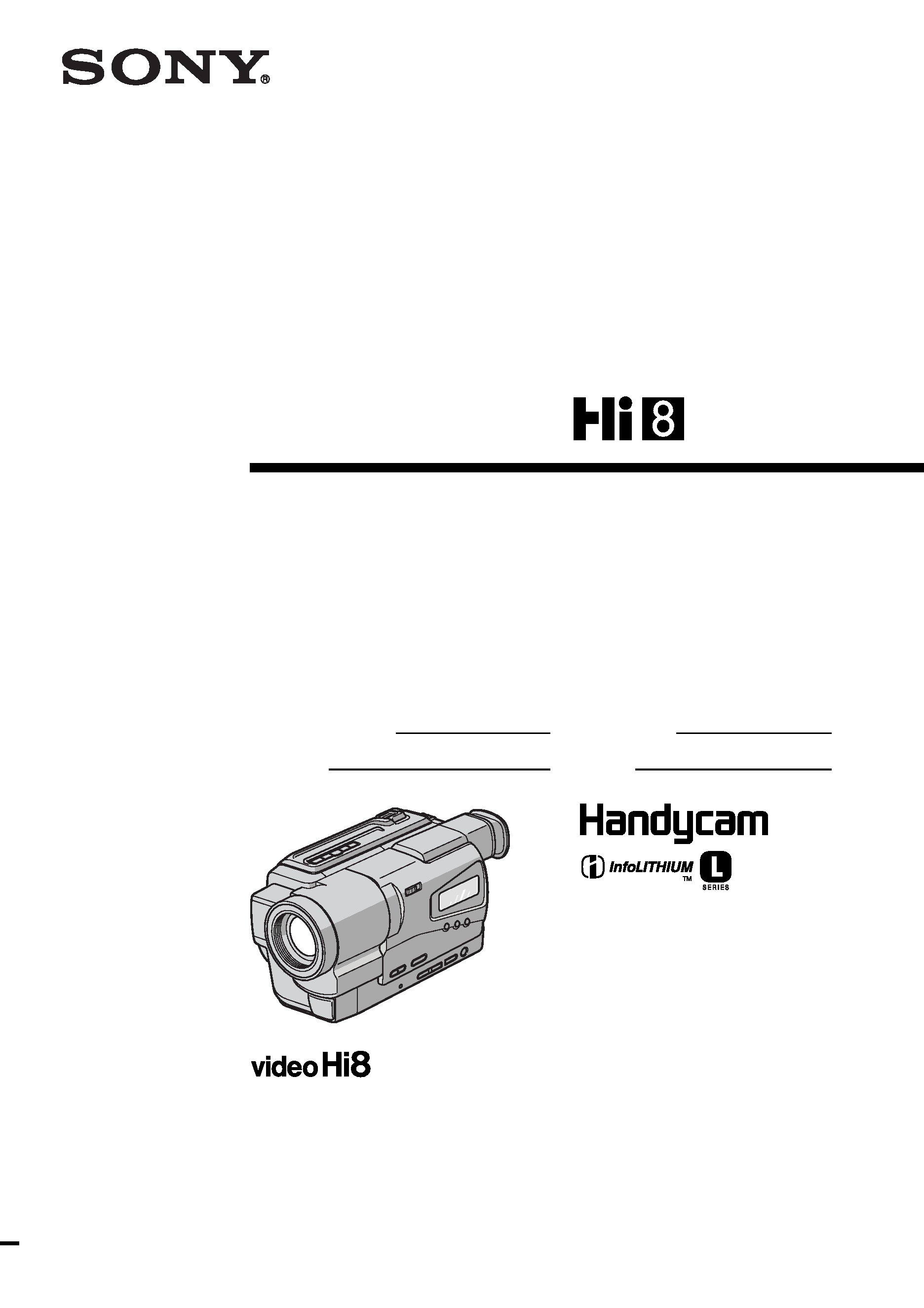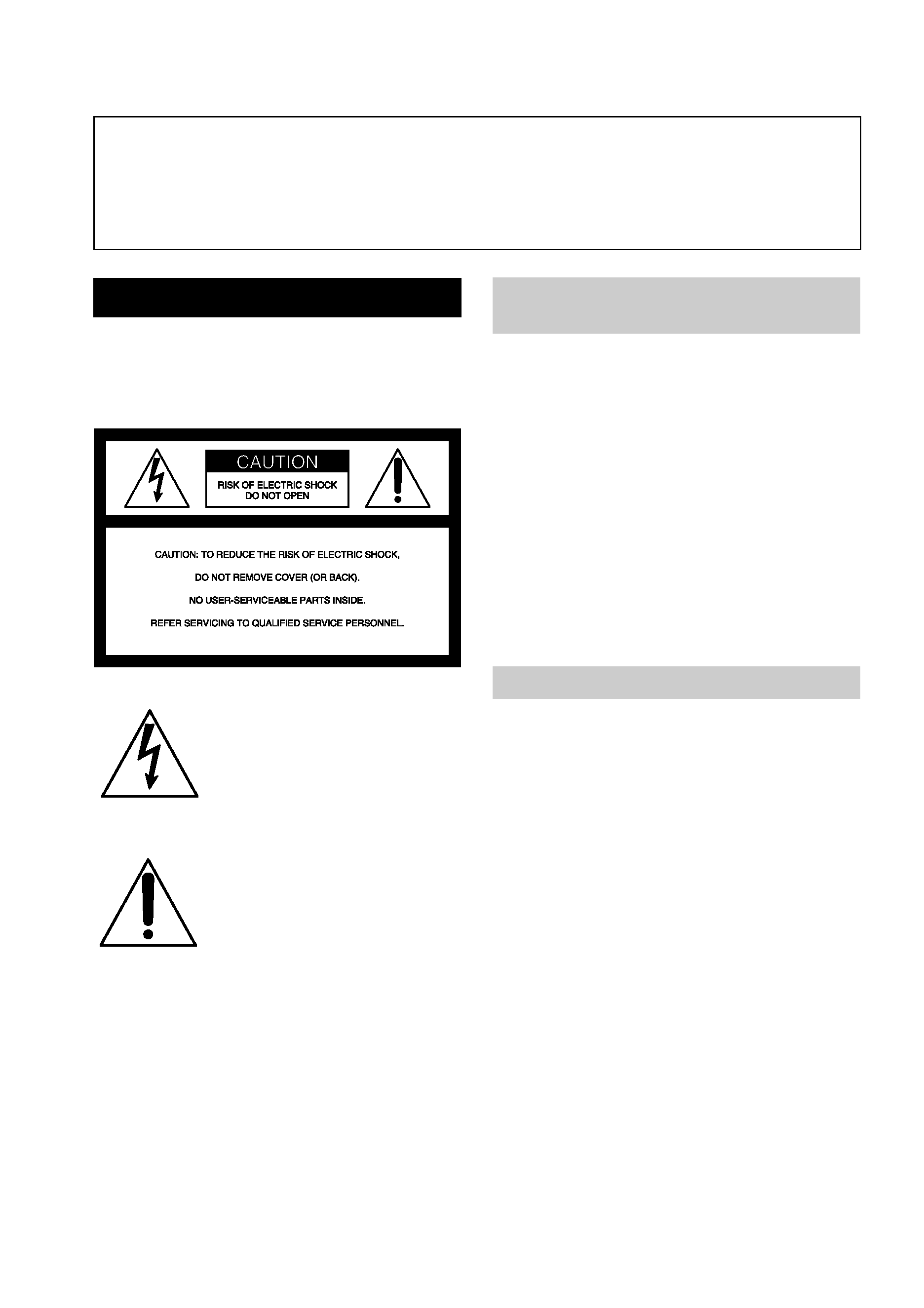
Video Camera
Recorder
Model No. CCD-TR
Model No. AC-L
Serial No.
Serial No.
3-065-645-11 (3)
©2001 Sony Corporation
CCD-TR618/TR818
Operating Instructions
Before operating the unit, please read this manual thoroughly,
and retain it for future reference.
Owner's Record
The model and serial numbers are located on the bottom. Record the
serial number in the space provided below. Refer to these numbers
whenever you call upon your Sony dealer regarding this product.
CCD-TR818

2
Welcome!
Congratulations on your purchase of this Sony Handycam® camcorder. With your
Handycam, you can capture life's precious moments with superior picture and sound quality.
Your Handycam is loaded with advanced features, but at the same time it is very easy to use.
You will soon be producing home video that you can enjoy for years to come.
WARNING
To prevent fire or shock hazard, do
not expose the unit to rain or
moisture.
For customers in the United
States and Canada
DISPOSAL OF LITHIUM ION BATTERY.
LITHIUM ION BATTERY.
DISPOSE OF PROPERLY.
You can return your unwanted lithium ion batteries
to your nearest Sony Service Center or Factory
Service Center.
Note:
In some areas the disposal of lithium ion
batteries in household or business trash may
be prohibited.
For the Sony Service Center nearest you call
1-800-222-SONY (United States only)
For the Sony Factory Service Center nearest you call
416-499-SONY (Canada only)
Caution: Do not handle damaged or leaking lithium
ion battery.
For customers in the U.S.A.
CAUTION
You are cautioned that any changes or modifications
not expressly approved in this manual could void
your authority to operate this equipment.
This symbol is intended to alert
the user to the presence of
uninsulated "dangerous voltage"
within the product's enclosure
that may be of sufficient
magnitude to constitute a risk of
electric shock to persons.
This symbol is intended to alert
the user to the presence of
important operating and
maintenance (servicing)
instructions in the literature
accompanying the appliance.
Never expose the battery pack to temperatures
above 60°C (140°F) such as in a car parked in
the sun or under direct sunlight.

3
Getting
started
Note:
This equipment has been tested and found to
comply with the limits for a Class B digital
device, pursuant to Part 15 of the FCC Rules.
These limits are designed to provide
reasonable protection against harmful
interference in a residential installation. This
equipment generates, uses, and can radiate
radio frequency energy and, if not installed
and used in accordance with the instructions,
may cause harmful interference to radio
communications. However, there is no
guarantee that interference will not occur in a
particular installation. If this equipment does
cause harmful interference to radio or
television reception, which can be determined
by turning the equipment off and on, the user
is encouraged to try to correct the interference
by one or more of the following measures:
-- Reorient or relocate the receiving antenna.
-- Increase the separation between the
equipment and receiver.
-- Connect the equipment into an outlet on a
circuit different from that to which the
receiver is connected.
-- Consult the dealer or an experienced radio/
TV technician for help.
For customers in CANADA
CAUTION
TO PREVENT ELECTRIC SHOCK, MATCH
WIDE BLADE OF PLUG TO WIDE SLOT,
FULLY INSERT.

4
Main Features
Functions to adjust exposure (in the recording mode)
·In a dark place
·In dark environments such as sunset, fireworks,
or general night views
·Shooting backlit subjects
·In spotlight, such as at the theater or a formal
event
·In strong light or reflected light, such as at a beach
in midsummer or on a ski slope
Functions to give images more impact (in the recording mode)
·Smooth transition between scenes
·Digital processing of images
·Creating a soft background for subjects
·Superimposing a title
Functions to give a natural appearance to your recordings
(in the recording mode)
·Preventing deterioration of picture quality in
digital zoom
The default setting is set to OFF.
(To zoom greater than 20
×, select the digital zoom
power in D ZOOM in the menu settings.)
·Focusing manually
·Shooting distant subjects
·Recording fast-moving subjects
Functions to use in editing (in the recording mode)
·Watching the picture on a wide-screen TV
·Recording with the date/time
·Enhancing old tapes
Functions to use after recording (in the playback mode)
·Correcting jitter
·Correcting color noise
NIGHTSHOT (p. 24)
Sunset & moon mode (p. 34)
BACK LIGHT (p. 24)
Spotlight mode (p. 34)
Beach & ski mode (p. 34)
FADER (p. 31)
PICTURE EFFECT (p. 33)
Soft portrait mode (p. 34)
TITLE (p. 38)
D ZOOM [MENU] (p. 47)
Manual focus (p. 37)
Landscape mode (p. 34)
Sports lesson mode (p. 34)
Wide mode (p. 29)
Date and time (p. 25)
ORC [MENU] (p. 49)
TBC [MENU] (p. 48)
DNR [MENU] (p. 48)

Getting
started
5
Table of contents
Main Features .......................................... 4
Quick Start Guide ............................... 6
Getting started
Using this manual ................................... 8
Checking supplied accessories ............ 10
Step 1 Preparing the power supply ... 11
Installing the battery pack ............ 11
Charging the battery pack ............ 12
Connecting to a wall outlet ........... 16
Step 2 Setting the date and time ........ 17
Step 3 Inserting a cassette ................... 19
Recording Basics
Recording a picture .............................. 20
Shooting backlit subjects
BACK LIGHT ........................ 24
Shooting in the dark
NightShot ............................... 24
Superimposing the date and time
on pictures ................................ 25
Playback Basics
Connections for playback .................... 26
Playing back a tape ............................... 27
Advanced Recording
Operations
Using the wide mode ........................... 29
Using the fader function ...................... 31
Using special effects
Picture effect ................................. 33
Using the PROGRAM AE function .... 34
Adjusting the exposure manually ...... 36
Focusing manually ................................ 37
Superimposing a title ........................... 38
Making your own titles ........................ 40
Using the built-in light ......................... 42
Editing
Dubbing a tape ...................................... 45
Customizing Your Camcorder
Changing the menu settings ................ 46
Troubleshooting
Types of trouble and their solutions
........................................................... 52
Self-diagnosis display .......................... 55
Warning indicators and messages ...... 56
Additional Information
Usable cassettes and playback modes
........................................................... 57
About "InfoLITHIUM" battery ........... 58
Using your camcorder abroad ............ 59
Maintenance information and
precautions ...................................... 60
Specifications ......................................... 65
Quick Reference
Identifying the parts and controls ...... 66
Index ........................................ Back cover
